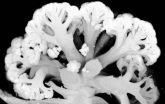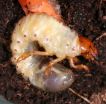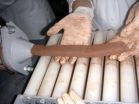(Press-News.org) A research coordinated by the UAB has succeeded in testing a vaccine against leishmaniasis. The vaccine was tested with the best animal model existing, the golden hamster, and can be produced at low costs by using insect larvae. The research, published in the latest edition of PLoS ONE, is an important step towards the fight against a disease which causes the death of 70,000 people each year in developing countries and of countless dogs, which also suffer from this disease and are its natural reservoir.
Leishmaniasis is one of the main health problems existing at global scale. It is produced by the protozoan Leishmania infantum, and canines, which can also be infected with the disease, are the main reservoirs of the organism. The disease is transmitted by insects from the Phlebotominae subfamily (sandflies), which are very similar to mosquitos. Clinical manifestations can go anywhere from minor skin sores to organ complications and, in the worst cases, death. The disease causes 70,000 deaths a year, mainly in developing countries, and affects over 12 million people around the world. Some 1.5 to 2 million new cases appear each year and an additional 350 million people are at risk of contracting the disease. Leishmaniasis is considered an endemic disease in parts of Asia, Africa, southern Europe, Mexico, Central America and South America. With the AIDS epidemic, leishmaniasis in humans has reactivated in many countries. Current treatments are unsatisfactory and, even though the most reasonable via to fight the disease would be to obtain an efficient vaccine, conventional vaccines until now have failed.
The research team led by the UAB compared the results of applying different vaccine strategies to the best animal model in which to study the human variant of the disease: the golden hamster. The results show that the most effective strategy is a combination of two vaccines created by the researchers: three doses of DNA with genes from the L. infantum and two doses of proteins coded by these genes.
The protein vaccine can be obtained at a low cost thanks to the use of insect larvae. To create the vaccine scientists isolated protozoan genes, inserted them into a virus which affects insects (baculovirus) and used these to infect larvae of a small worm, the cabbage looper (Trichoplusia ni). The larvae act as bioreactors and produce in large amounts – and at a much lower cost than conventional reactors based on microorganisms – the proteins which code these genes, and which are responsible for a protective response in vaccinated individuals. Using this method, a DNA vaccine can be manufactured with the protozoan protein coding genes, and a second vaccine with proteins associated with these genes (produced at a low cost using insect larvae), with the aim of increasing its effectiveness. This vaccine strategy can be used both in a preventive and a therapeutic manner, in both humans and dogs. Presently, the possibility of a translational phase is being contemplated with the aim of transferring as quickly as possible the results of this basic research to clinical practices, and of increasing the efficacy even more by using drugs to boost the immune response.
###The research, directed by researcher Alhelí Rodríguez and lecturer Jordi Alberola, both from the Department of Pharmacology, Therapeutics and Toxicology at the UAB, and members of the UAB Drug Analysis Service, included the participation of INIA (National Institute for Agrarian Technology and Research), the firm Alternative Gene Expression S.L., CReSA (Animal Health Research Centre, with the participation of the UAB and IRTA), and the University of Sao Paulo, Brazil. The research was published in the latest edition of the PLoS ONE journal.
Reference:
Todolí F., Rodríguez-Cortés A., Núñez M. del Carmen, Laurenti M.D., Gómez-Sebastián S., et al. (2012) "Head-to-Head Comparison of Three Vaccination Strategies Based on DNA and Raw Insect-Derived Recombinant Proteins against Leishmania." PLoS ONE 7(12): e51181. doi:10.1371/journal.pone.0009617
Contact researcher:
Jordi Alberola
Department of Pharmacology, Therapeutics and Toxicology
Faculty of Veterinary Medicine
Universitat Autònoma de Barcelona
Tel: +34 93 581 1532
Jordi.Alberola@uab.es
Successful results against human leishmaniasis with a more efficient and economic vaccine
Leishmaniasis is the second most mortal tropical parasitic disease
2012-12-19
ELSE PRESS RELEASES FROM THIS DATE:
A mathematical formula to decipher the geometry of surfaces like that of cauliflower
2012-12-19
This press release is available in Spanish.
VIDEO:
This is a cauliflower.
Click here for more information.
The scientists have found a formula that describes how the patterns found in a multitude of natural structures are formed. "We have found a model that describes, in detail, the evolution in time and in space of cauliflower-type fractal morphologies for nanoscopic systems", explains ...
Geo-engineering against climate change
2012-12-19
Numerous geo-engineering schemes have been suggested as possible ways to reduce levels of the greenhouse gas carbon dioxide in the atmosphere and so reduce the risk of global warming and climate change. One such technology involves dispersing large quantities of iron salts in the oceans to fertilize otherwise barren parts of the sea and trigger the growth of algal blooms and other photosynthesizing marine life. Photosynthesis requires carbon dioxide as its feedstock and when the algae die they will sink to the bottom of the sea taking the locked in carbon with them.
Unfortunately, ...
Better approach to treating deadly melanoma identified by scientists
2012-12-19
Scientists at The University of Manchester have identified a protein that appears to hold the key to creating more effective drug treatments for melanoma, one of the deadliest cancers.
Researchers funded by Cancer Research UK have been looking at why new drugs called "MEK inhibitors", which are currently being tested in clinical trials, aren't as effective at killing cancer cells as they should be.
They discovered that MITF - a protein that helps cells to produce pigment but also helps melanoma cells to grow and survive - is able to provide cancer cells with a resistance ...
Fast-acting enzymes with 2 fingers: Protein structurally and dynamically explained
2012-12-19
Researchers at the RUB and from the MPI Dortmund have uncovered the mechanism that
switches off the cell transport regulating proteins. They were able to resolve in detail how the central switch protein Rab is down-regulated with two "protein fingers" by its interaction partners. The structural and dynamic data is reported by the researchers led by Prof. Dr. Klaus Gerwert (Chair of Biophysics, RUB) and Prof. Dr. Roger S. Goody (Max Planck Institute for Molecular Physiology, Dortmund, Germany) in the Online Early Edition of the journal PNAS. "Unlike in the cell growth protein ...
Badger sleeping habits could help target TB control
2012-12-19
Scientists found that badgers which strayed away from the family burrow in favour of sleeping in outlying dens were more likely to carry TB.
The 12-month study of 40 wild badgers was funded by the Department for Environment, Food and Rural Affairs (Defra) and could have implications for the management of bovine TB in parts of the UK. The behaviour of individual animals is thought to be a key factor in how the disease is spread among animals and livestock. The new findings could help to understand and develop measures to manage TB in badgers.
The study is published ...
The role of the innate immune cells in the development of type 1 diabetes
2012-12-19
The researchers reveal the role of the innate immune cells, especially the dendritic cells, that cause the activation of the killer T-lymphocytes whose action is directed against the p pancreatic cells. The results obtained in mice make it possible to consider new ways of regulating the auto-immune reaction generated by the innate immune cells.
Type 1 diabetes, or insulin-dependent diabetes, is an auto-immune disease characterised by the destruction of insulin-producing pancreatic β cells that are present in the Islets of Langerhans which are themselves in the pancreas. ...
Not without my microbes
2012-12-19
Apart from the common European cockchafer (Melolontha melolontha), the European forest cockchafer (Melolontha hippocastani) is the most common species of the Melolontha genus. These insects can damage huge areas of broadleaf trees and conifers in woodlands and on heaths. Cockchafers house microbes in their guts that help them to digest their woody food, such as lignocelluloses and xylans. Scientists of the Max Planck Institute for Chemical Ecology in Jena, Germany, have now performed comprehensive RNA analyses and identified the microbiota of cockchafer larvae feeding on ...
Scale-up of a temporary bioartificial liver support system described in BioResearch Open Access
2012-12-19
New Rochelle, NY, December 19, 2012—Acute liver failure is usually fatal without a liver transplant, but the liver can regenerate and recover if given time to heal. A bioartificial liver machine that can provide temporary support while organ regeneration takes place has been scaled up for testing in a large animal model and is described in an article in BioResearch Open Access, a bimonthly peer-reviewed open access journal from Mary Ann Liebert, Inc., publishers. The article is available on the BioResearch Open Access website .
A team of researchers from University College ...
When the ice melts, the Earth spews fire
2012-12-19
In 1991, it was a disaster for the villages nearby the erupting Philippine volcano Pinatubo. But the effects were felt even as far away as Europe. The volcano threw up many tons of ash and other particles into the atmosphere causing less sunlight than usual to reach the Earth's surface. For the first few years after the eruption, global temperatures dropped by half a degree. In general, volcanic eruptions can have a strong short-term impact on climate. Conversely, the idea that climate may also affect volcanic eruptions on a global scale and over long periods of time is ...
Paper waste used to make bricks
2012-12-19
Researchers at the University of Jaen (Spain) have mixed waste from the paper industry with ceramic material used in the construction industry. The result is a brick that has low thermal conductivity meaning it acts as a good insulator. However, its mechanical resistance still requires improvement.
"The use of paper industry waste could bring about economic and environmental benefits as it means that material considered as waste can be reused as raw material." – This is one of the conclusions of the study developed by researchers at the Upper Polytechnic School of Linares ...
LAST 30 PRESS RELEASES:
What causes some people’s gut microbes to produce high alcohol levels?
Global study reveals widespread burning of plastic for heating and cooking
MIT study shows pills that communicate from the stomach could improve medication adherence
Searching for the centromere: diversity in pathways key for cell division
Behind nature’s blueprints
Researchers search for why some people’s gut microbes produce high alcohol levels
Researchers find promising new way to boost the immune response to cancer
Coffee as a staining agent substitute in electron microscopy
Revealing the diversity of olfactory receptors in hagfish and its implications for early vertebrate evolution
Development of an ultrasonic sensor capable of cuffless, non-invasive blood pressure measurement
Longer treatment with medications for opioid use disorder is associated with greater probability of survival
Strategy over morality can help conservation campaigns reduce ivory demand, research shows
Rising temperatures reshape microbial carbon cycling during animal carcass decomposition in water
Achieving ultra-low-power explosive jumps via locust bio-hybrid muscle actuators
Plant-derived phenolic acids revive the power of tetracycline against drug-resistant bacteria
Cooperation: A costly affair in bacterial social behaviour?
Viruses in wastewater: Silent drivers of pollution removal and antibiotic resistance
Sub-iethal water disinfection may accelerate the spread of antibiotic resistance
Three in four new Australian moms struggle with body image
Post-stroke injection protects the brain in preclinical study
Cardiovascular risk score predicts multiple eye diseases
Health: estimated one in ten British adults used or interested in GLP-1 medications for weight loss
Exercise to treat depression yields similar results to therapy
Whooping cough vaccination for pregnant women strengthens babies’ immune system
Dramatic decline in new cases of orphanhood in Uganda driven by HIV treatment and prevention programs
Stopping weight loss drugs linked to weight regain and reversal of heart health markers
Higher intake of food preservatives linked to increased cancer risk
Mass General Brigham–developed cholera vaccine completes phase 1 trial
First experimental validation of a “150-year-old chemical common sense” direct visualization of the molecular structural changes in the ultrafast anthracene [4+4] photocycloaddition reaction
Lack of support for people on weight loss drugs leaves them vulnerable to nutritional deficiencies, say experts
[Press-News.org] Successful results against human leishmaniasis with a more efficient and economic vaccineLeishmaniasis is the second most mortal tropical parasitic disease



